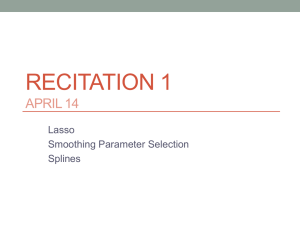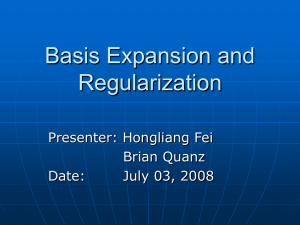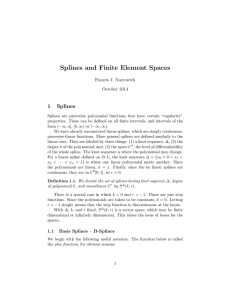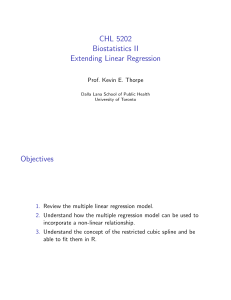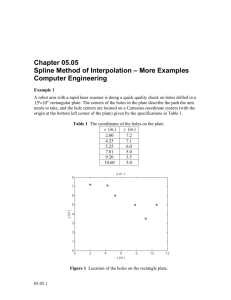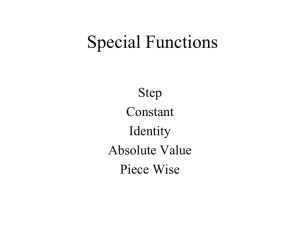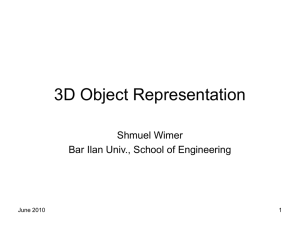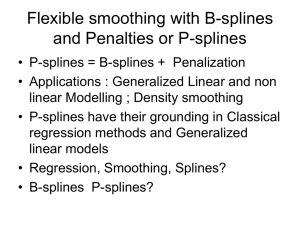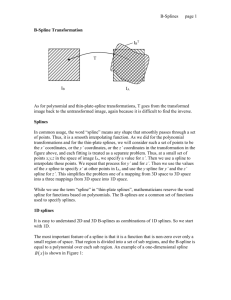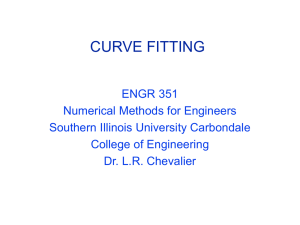Lecture 6 slides
advertisement
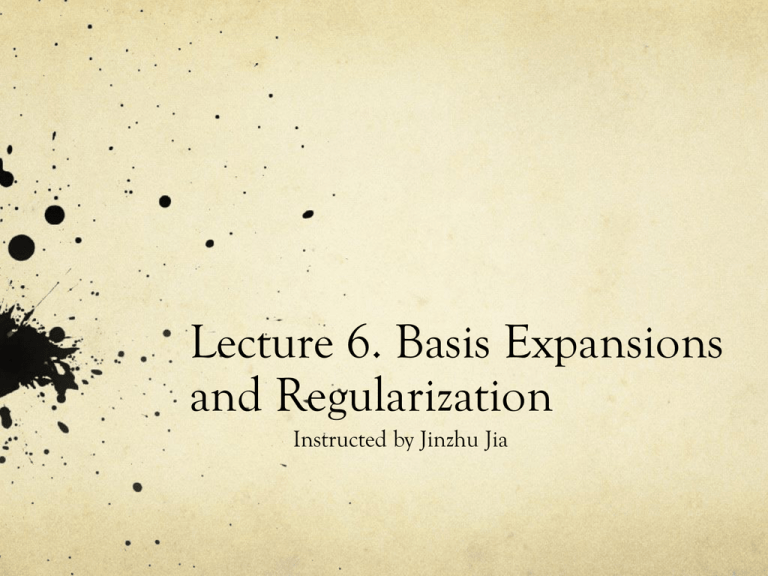
Lecture 6. Basis Expansions and Regularization Instructed by Jinzhu Jia Outline Background Piecewise-polynomial Splines Wavelet Dictionary learning Background: Moving beyond Linear Model Linear regression, LDA, Logistic Regression and separating hyperplanes —— linear models Why ? Simple? Taylor expansion? Non-Overfitting? Moving beyond linear model via transformation: hm(X) : basis function. Beauty: Linear again! Background: Examples O(p^d) for a degree-d polynomial Background: How many basis do we use? Restriction methods Selection methods: feature selection methods —— stagewise for example Regularization methods: ridge regression for example. Piecewise Polynomials and Splines Piecewise Linear (constant) • • Supose that 𝜉1 and 𝜉2 are known 𝑓 𝑋 = 𝛽1 ℎ1 𝑋 + 𝛽2 ℎ2 𝑋 + 𝛽3 ℎ3 𝑋 • Least square estimate: 𝛽𝑚 = 𝑌𝑚 • Degree of freedom: K+1 Piecewise Linear (Cont’) • • Supose that 𝜉1 and 𝜉2 are known 𝑓 𝑋 = 𝑚 𝛽𝑚 ℎ𝑚 𝑋 , where • • These parameters can be estimated via OLS Degree of freedom: 2(K+1) Piecewise Linear (Cont’) • • • • Supose that 𝜉1 and 𝜉2 are known 𝑓 𝑋 = 𝑚 𝛽𝑚 ℎ𝑚 𝑋 , where With two constraints: 𝑓 𝜉1 − = 𝑓 𝜉1 + 𝑎𝑛𝑑 𝑓 𝜉2 − = 𝑓(𝜉2 +) 𝛽1 + 𝛽4 𝜉1 = 𝛽2 + 𝛽5 𝜉1 𝑎𝑛𝑑 𝛽2 + 𝛽5 𝜉2 = 𝛽3 + 𝛽6 𝜉2 These parameters can be estimated via OLS Piecewise Linear (Cont’) Degree of freedom: (K+1) *4 Piecewise Cubic Degree of freedom: (K+1) *4 -K Cubic Spline Degree of freedom: (K+1) *4 –K*2 Exercise! Degree of freedom: (K+1) *4 – K*3 Piecewise Polynomial K knots, order M spline: It is claimed that cubic splines are the lowest order splines for which the knot discontinuity is not visible to the human eye! Widely used: piecewise constant, piecewise linear and cubie spline Basis functions are not unique! B-spline basis is more efficient DF: M+K Piecewise Polynomial (Cont’) These fixed-knot splines are also known as regression splines. Regression splines are determined by the order of spline, the number of knots and their placement R: bs(x,df=7) generates a basis matrix of cubic-spline functions M = 4, K = df – M + 1 =7-3 = 4 knots By default, the four knots are (20th,40th ,60th and 80th ) percentiles of x bs(x,degree = 1, knots= c(0.2,0.4,0.6)) generates an 𝑁 × 4 matrix Natural Cubic Splines 𝑋 ∼ 𝑈 0,1 𝑌 = 𝑋 + 𝑁 0,1 n= 50 Cubic spline: two knots at 0.33 and 0.66 Natural spline: two boundary knots at 0.1 and 0.9, four interior knots uniformly spaced between them Pointwise variance curves 𝑌 = ℎ𝑚 𝑋 𝛽𝑚 + ϵ = 𝐻𝛽 + ϵ 𝛽 = (𝐻𝑇 𝐻)−1 𝐻𝑇 𝑌 𝑣𝑎𝑟 𝛽 = (𝐻𝑇 𝐻)−1 𝜎 2 𝑣𝑎𝑟 𝐻 𝛽 = 𝐻(𝐻𝑇 𝐻)−1 𝐻𝑇 𝜎 2 Natural Cubic Splines Two more constraints: linear beyond the boundary knots: frees 4 parameters K knots, K basis: K + 4 -4 Example: South African Heart Disease Four natural spline bases for each term are used 5 ? knots (3 chosen at random as interior knots, 2 boundary knots at the extremes) [?—exclude the constant term for each ℎ𝑗 ] Binary variable is kept as itself Example: South African Heart Disease (Cont’) Example: Phoneme Recognition Restrictions: 𝛽 𝑓 is continuous in 𝑓 Smoothing Splines To avoid Knot selection Regularization 𝜆 is called smooth parameter, because The solution of min 𝑅𝑆𝑆(𝑓, 𝜆)is a natural cubic spline with knots at 𝑥𝑖 . ——Exercise! 𝑓 Smoothing Splines Example Smoothing Parameter Selection • Specify fix degree of freedom Tr(S) R> smooth.spline(x,y,df=??) Try a couple of values of df. and choose one based on a model selection criteria Integrated EPE K-fold CV to choose the value of Smoothing Parameter Selection(Cont’) True Function Fitted Function Smoothing Parameter Selection(Cont’) Df: degree of freedom. Nonparametric Logistic Regression Multidimensional Splines Wavelet Smoothing Wavelet Smoothing Wavelet Smoothing Dictionary Learning Dictionary Learning Cane we learn a good dictionary? Dictionary Learning Homework Due Apr 25 ESLII_print 5, pp181. Exercise: 1,3,4,5,7,10
